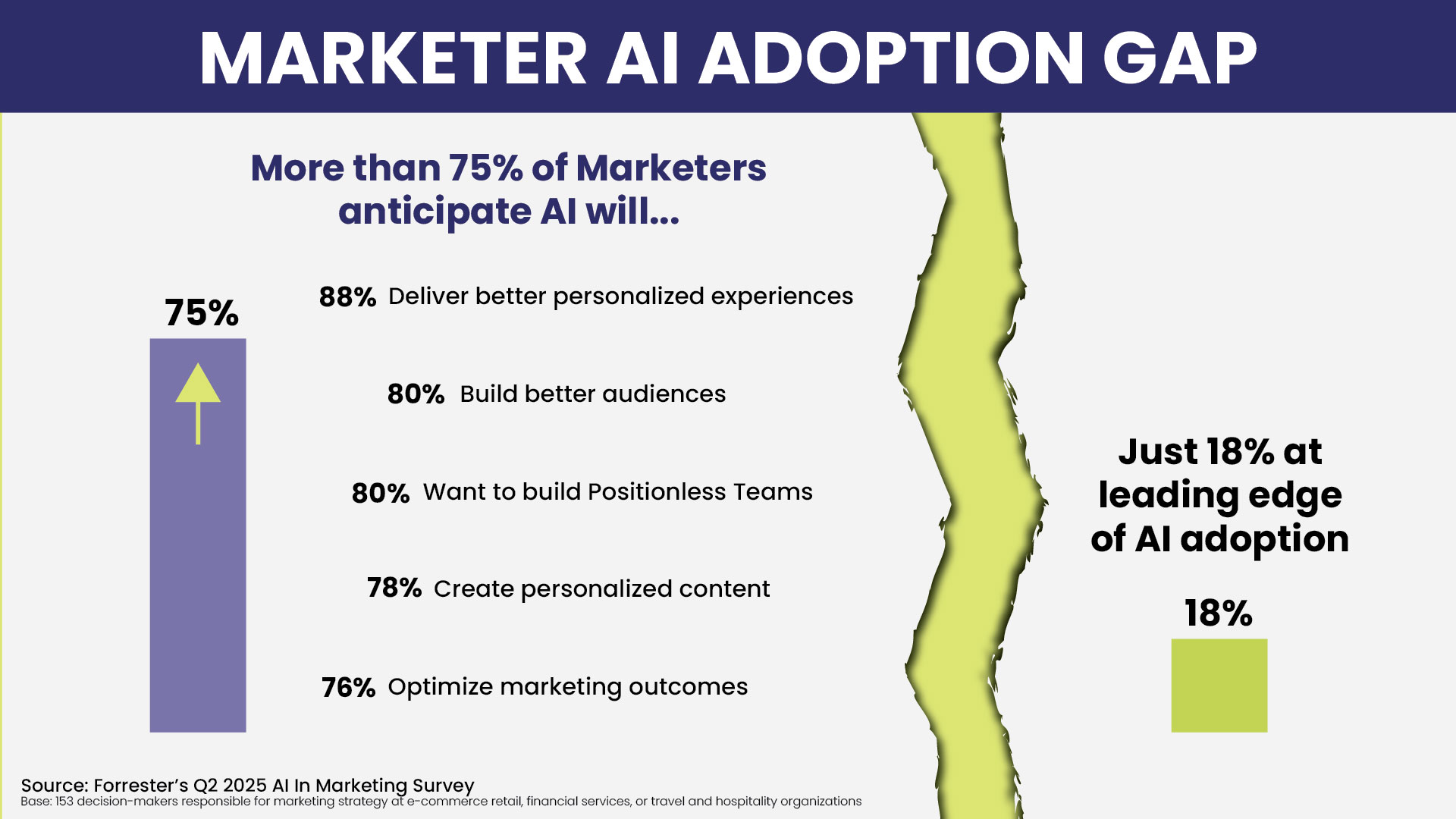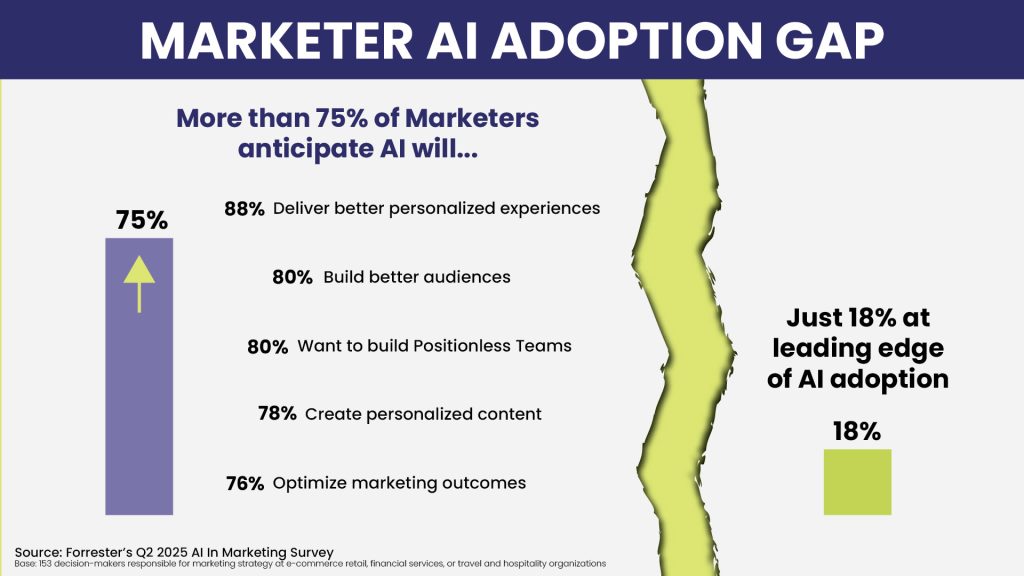82% of marketers fail AI adoption (Positionless Marketing can fix it) by Optimove


Picture a chocolate company with an elaborate recipe, generations old. They ask an AI system to identify which ingredients they could remove to cut costs. The AI suggests one. They remove it. Sales hold steady. They ask again. The AI suggests another. This continues through four or five iterations until they’ve created the cheapest possible version of their product. Fantastic margins, terrible sales. When someone finally tastes it, the verdict is immediate: “This isn’t even chocolate anymore.”
Aly Blawat, senior director of customer strategy at Blain’s Farm & Fleet, shared this story during a recent MarTech webinar to illustrate why 82% of marketing teams are failing at AI adoption: automation without human judgment doesn’t just fail. It compounds failure faster than ever before. And that failure has nothing to do with the technology itself.
The numbers tell the story. In a Forrester study commissioned by Optimove, only 18% of marketers consider themselves at the leading edge of AI adoption, even though nearly 80% expect AI to improve targeting, personalization and optimization. Forrester’s Rusty Warner, VP and principal analyst, puts this in context: only about 25% of marketers worldwide are in production with any AI use cases. Another third are experimenting but haven’t moved to production. That leaves more than 40% still learning about what AI might do for them.
“This particular statistic didn’t really surprise me,” Warner said. “We find that a lot of people that are able to use AI tools at work might be experimenting with them at home, but at work, they’re really waiting for their software vendors to make tools available that have been deemed safe to use and responsible.”
The caution is widespread. IT teams have controls in place for third-party AI tools. Even tech-savvy marketers who experiment at home often can’t access those tools at work until vendors embed responsible AI, data protections and auditability directly into their platforms.
The problem isn’t the AI tools available today. It’s that marketing work is still structured the same way it was before AI existed.
The individual vs. the organization
Individual marketers are thirsty for AI tools. They see the potential immediately. But organizations are fundamentally built for something different: control over brand voice, short-term optimization and manual processes where work passes from insights teams to creative teams to activation teams, each handoff adding days or weeks to cycle time.
Most marketing organizations still operate like an assembly line. Insights come from one door, creative from another, activation from a third. Warner called this out plainly: “Marketing still runs like an assembly line. AI and automation break that model, letting marketers go beyond their position to do more and be more agile.”
The assembly line model is excellent at governance and terrible at speed. By the time results return, they inform the past more than the present. And in a world where customer behavior shifts weekly, that lag becomes fatal.
The solution is “Positionless Marketing,” a model where a single marketer can access data, generate brand-safe creative and launch campaigns with built-in optimization, all without filing tickets or waiting for handoffs. It doesn’t mean eliminating collaboration. It means reserving human collaboration for major launches, holiday campaigns and sensitive topics while enabling marketers to go end-to-end quickly and safely for everything else.
Starting small, building confidence
Blain’s Farm & Fleet, a 120-year-old retail chain, began its AI journey with a specific problem: launching a new brand campaign and needing to adapt tone consistently across channels. They implemented Jasper, a closed system where they could feed their brand tone and messaging without risk.
“We were teaching it a little bit more about us,” Blawat said. “We wanted to show up cohesively across the whole entire ecosystem.”
Warner recommends this approach. “Start small and pick something that you think is going to be a nice quick win to build confidence,” he said. “Audit your data, make sure it’s cleaned up. Your AI is only going to be as good as the data that you’re feeding it.”
The pattern repeats: start with a closed-loop copy tool, then add scripts to clean product data, then layer in segmentation. Each step frees time, shortens cycles, and builds confidence.
Where data meets speed
Marketers aren’t drowning in too little data. They’re drowning in too much data with too little access. The 20% of marketing organizations that move fast centralize definitions of what “active customer,” “at risk,” and “incremental lift” actually mean. And they put those signals where marketers work, not in a separate BI maze.
“There’s massive potential for AI, but success hinges on embracing the change required,” Warner said. “And change is hard because it involves people and their mindset, not just the technology.”
The adoption lag isn’t about technology readiness. It’s about organizational readiness.
Balancing automation and authenticity
Generative AI took off first in low-risk applications: creative support, meeting notes, copy cleanup. Customer-facing decisions remain slower to adopt because brands pay the price for mistakes. The answer is to deploy AI with guardrails in the highest-leverage decisions, prove lift with holdouts and expand methodically.
Blawat emphasized this balance. “We need that human touch on a lot of this stuff to make sure we’re still showing up as genuine and authentic,” she said. “We’re staying true to who our brand is.”
For Blain’s Farm & Fleet, that means maintaining the personal connection customers expect. The AI handles the mechanics of targeting and timing. But humans ensure every message reflects the values and voice customers’ trust.
The future of marketing work
AI is moving from analysis to execution. When predictive models, generative AI and decisioning engines converge, marketers stop drawing hypothetical journeys and start letting the system assemble unique paths per person.
What changes? Less canvas drawing, more outcome setting. Less reporting theater, more lift by cohort. Fewer meetings, faster iterations.
Warner points to a future that’s closer than most organizations realize. “Imagine a world where I don’t come to your commerce site and browse. Instead, I can just type to a bot what it is I’m looking for. And I expect your brand to be responsive to that.”
That kind of conversational commerce will require everyone in the organization to become a customer experience expert. “It doesn’t matter what channel the customer uses,” Warner explained. “They’re talking to your brand.”
The path forward
There is no AI strategy without an operating model that can use it. The fix requires three fundamental changes: restructure how marketing work flows, measure lift instead of activity and enable marketers to move from idea to execution without handoffs.
The path forward requires discipline. Pick one customer-facing use case with clear financial upside. Define the minimum signals, audiences and KPIs needed. Enforce holdouts by default. Enable direct access to data, creative generation and activation in one place. Publish weekly lift by cohort. Expand only when lift is proven.
Warner expects adoption to accelerate significantly in 2026 as more vendors embed AI capabilities with proper guardrails. For brands like Blain’s Farm & Fleet, that future is already taking shape. They started with copywriting, proved value and are now expanding. The key was finding specific problems where AI could help and measuring whether it actually did.
AI will not fix a slow system. It will amplify it. Teams that modernize the way work gets done and lift the language of decisions will see the promise translate into performance.
As Blawat’s chocolate story reminds us, automation without judgment optimizes for the wrong outcome. The goal isn’t the cheapest product or the fastest campaign. It’s the one that serves customers while building the brand. That requires humans in the loop to point AI in the ri







Recent Comments